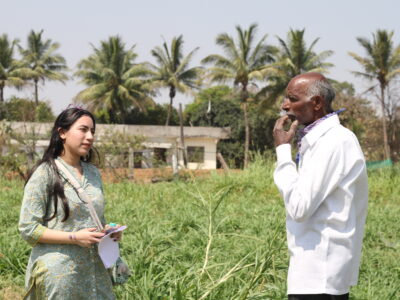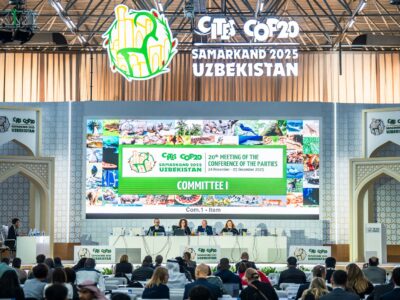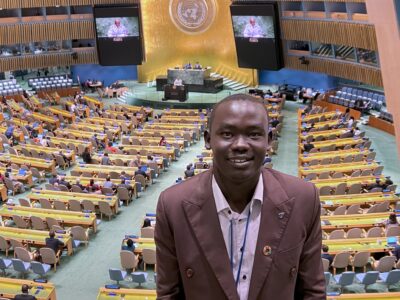When Cindy Zhang first heard about the crippling snowstorm that hit Texas in 2021, she was studying the state’s power system from an economic perspective. Today, Zhang, whose background is in finance, has a more comprehensive understanding of the breadth and complexity of climate risks, because of An Introduction to Complex Climate Risks, a summer class she is taking at Columbia’s Climate School. Zhang said the class gave her additional context about the snowstorm and resulting power crisis that killed hundreds of people and caused an estimated $195 billion in damages.

An Introduction to Complex Climate Risks is taught by Kai Kornhuber, adjunct assistant professor of climate at the Climate School and a senior research scholar at IIASA. The key lesson from the class: climate impacts do not affect the environment or society in isolation. Because climate change is projected to lead to more frequent and severe extreme weather events, its impacts could result in cascading failures that can spread across socio-environmental systems and sectors, disproportionally affecting underserved communities. Extreme weather events can affect food, health, supply chains and finance systems as well as critical infrastructure such as water, energy, communication and transportation systems in ways that are challenging to anticipate and prepare for.

Because it is an introductory course, Kornhuber’s class brings together students—both graduates and undergraduates—from very different backgrounds, which, he says, makes class discussions more interesting. For example, Zayna Syed’s background is in journalism and public policy. “When I was a journalist in Arizona for a year, I saw how different aspects of climate change could build on each other. There’s a mega drought in the southwest, caused partially by climate change, that has dried out vegetation, and that, along with mismanagement, caused wildfires to become more severe and spread,” Syed said. “After a series of massive wildfires in northern Arizona, the land was scorched so it couldn’t absorb water as well, and then there was a huge monsoon that was more intense, again, because of climate change. And because the land couldn’t absorb the water, there was massive flooding in areas that weren’t in flood zones.”
Kornhuber’s class is an interdisciplinary one, exploring the foundations of climate physics, statistics and their relation to global warming and the most significant climate hazards, as well as compounding impacts—i.e., how single events can amplify consequences when they happen at the same time, in close succession or in the same region. “[The complexity of climate risks] is a necessary perspective that is often missing in the discussion around climate risks,” said Kornhuber. “For instance, during times of drought, it’s not only one sector that might be affected. You will have issues with energy generation when water levels are too low for transportation systems or too warm to be used for cooling in nuclear power plants. Heat and drought often occur at the same time, so there might be increased risk to agriculture and health risks for the elderly at the same time. And energy is needed, of course, to maintain the health infrastructure. So these things are all connected in a way, and in times of great distress, there might be a cascading infrastructure failure that then amplifies the impacts for other parts of the society.”

The class looks at case studies and discusses solutions. For example, the heat wave of 2003 in France was devastating, with over 60,000 recorded deaths. “After this event, France put in place specific heat emergency measures and a public awareness campaign, so heat waves that followed later, even though they were of similar magnitude, did not have those extreme impacts,” Kornhuber said. “These measures clearly helped to avoid extreme casualties.”
The students’ final assignment: to choose a specific extreme event and describe it from all possible perspectives, including the meteorological and climate conditions responsible for the extreme event, the compounding aspects that led to the greatest impacts, as well as adaptation measures that could help avoid such impacts in future. Alan Andres Garcia Lopez, a PhD student in the department of Earth and Environmental Sciences, is examining the extreme rainfall and flooding in South America that occurred in 2015. That year, El Niño altered atmospheric conditions, which resulted in heavy rainfall during the span of one month. “Extreme events and persistent rainfall produced very saturated soil and rivers that flooded, and this resulted in a lot of damage to infrastructure,” said Lopez. “Around 100,000 people were displaced in four countries. We wanted to look at the impacts of this flooding and also understand how El Niño modified the climate to produce this event. There were also other impacts from this type of rainfall, such as crop damage and vector-borne diseases. And Argentina was in an economic crisis, so responding to the events was difficult for institutions and the government.”

“My hope is that students will leave class with a very comprehensive idea of what climate risks are, how they act, and how they are driven by climate change, as well as how societies can prepare for them and what pitfalls need to be avoided,” said Kornhuber. He would like his students to be able to apply this understanding in their future academic careers, as practitioners in the private sector or wherever they might end up working, because he believes every sector and occupation needs awareness of the complexity of climate risks.
Zhang says she will probably end up working in finance in the future. “I think this class and the knowledge I’ve received from the climate school will prepare me to really consider climate risks and their consequences in the actions that the organizations I work for are taking. And even if I cannot become a climate officer, I could be in another related department and bring this climate knowledge into the core business of our organization. That’s my dream career.”
Added Kornhuber, “The task of science should be to educate students to become climate literate and put their knowledge into practice wherever their careers might take them. Such knowledge will help to put measures in place to prevent combined climate hazards from escalating and to anticipate their complex impact chains so we can be prepared before the worst events.”




Has anyone considered the effects of systems slowing and dumping massive amounts of rain and/or snow/ice on a specific region, with the subsequent colapse of power lines followed by extreme cold or heat. This nightmare scenario seems possible as weather systems slow or stagnate. Has anyone considered these scenarios and how to plan for them?